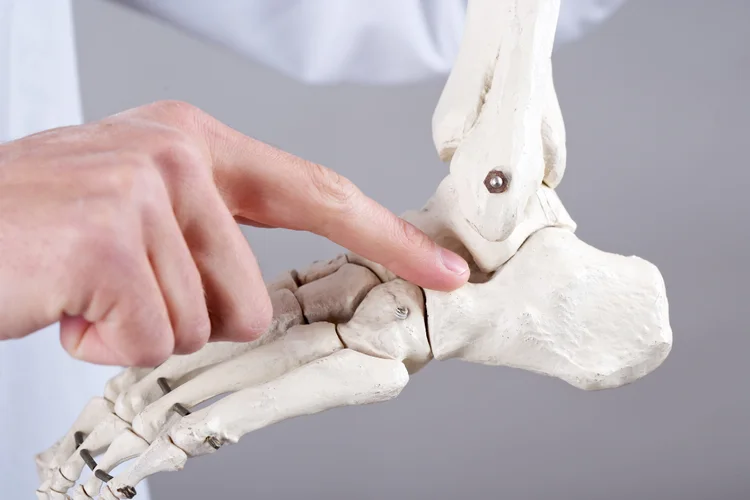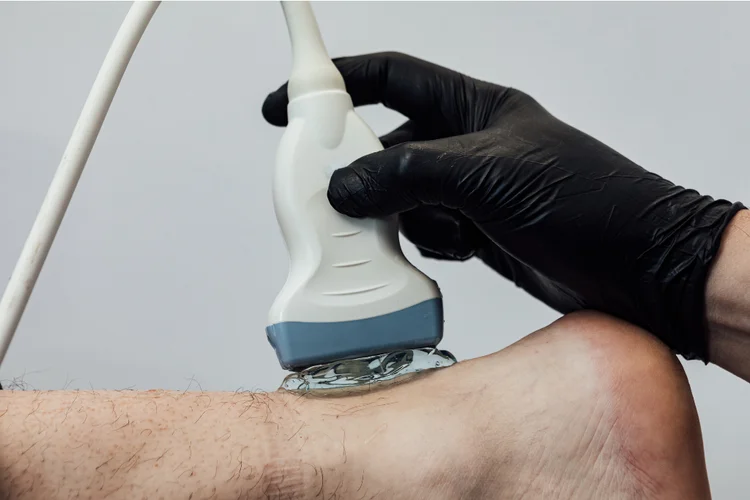Ankle Specialist Singapore
Ankle injuries such as sprains, tendonitis, or tears can impact mobility. Dr Foo provides precise diagnosis and targeted treatment, including ultrasound-guided care to promote recovery and prevent reinjury.
MBBS (University of London) | MMed (Ortho) | FRCSEd (Ortho) | FAMS (Ortho)



What Does an Ankle Specialist Do?
An ankle specialist, often an orthopaedic doctor or sports medicine physician, diagnoses,
treats, and manages conditions affecting the ankle joint, ligaments, tendons, and
surrounding structures.
This includes acute injuries such as sprains and fractures, chronic conditions like Achilles
tendinitis and tendon ruptures, and structural issues that affect stability and mobility.
Common Ankle Conditions Treated
Ankle specialists manage a range of conditions, from acute injuries to chronic degenerative disorders. These include:
- Ankle Sprains and Strains – Ligament injuries caused by sudden twisting, rolling, or excessive force on the ankle, often occurring during sports or daily activities.
- Chronic Ankle Instability – Weakness and recurrent ankle sprains due to improperly healed ligament injuries, leading to ongoing instability.
- Achilles Tendinitis – Inflammation of the Achilles tendon from repetitive stress or overuse, commonly seen in athletes and active individuals.
- Ankle Fractures – Breaks in one or more ankle bones, ranging from hairline (stress) fractures to severe displaced fractures.
- Osteoarthritis of the Ankle – Degeneration of cartilage in the ankle joint, resulting in stiffness, swelling, and chronic pain.
- Tendon Tears or Ruptures – Partial or complete tears of ankle tendons, such as the Achilles or peroneal tendons, affecting movement and stability.

Diagnosis and Assessment of Ankle Conditions
At Apex Sports Clinic, we take a thorough approach to diagnosis, comprising clinical evaluation, imaging, and specialised tests to identify the underlying cause of ankle pain, instability, or dysfunction.
1. Clinical Evaluation
- Medical History Review – Assessing symptoms, previous ankle injuries, underlying medical conditions, and activity levels that may contribute to ankle issues.
- Physical Examination – Evaluating the affected ankle for swelling, tenderness, bruising, range of motion, joint stability, and weight-bearing ability.
2. Imaging Tests
- X-ray – Uses low-dose radiation to capture images of the ankle bones, helping detect fractures, joint misalignments, and structural abnormalities.
- Magnetic Resonance Imaging (MRI) – Utilises magnetic fields and radio waves to generate high-resolution images of soft tissues, providing a detailed assessment of ligament sprains, tendon injuries, and cartilage damage.
- Computed Tomography (CT) Scan – Combines X-ray technology with computer processing to produce cross-sectional images, offering a clearer view of complex fractures and joint irregularities.
- Ultrasound – Uses high-frequency sound waves to create real-time images, allowing for the evaluation of tendon movement, ligament injuries, and fluid buildup within the joint.
3. Specialised Tests
- Gait and Biomechanical Analysis – Assesses walking patterns, foot alignment, and weight distribution to identify structural abnormalities that may contribute to ankle instability or dysfunction.
- Joint Aspiration – Involves withdrawing synovial fluid from the ankle joint to evaluate for infections, inflammation, or the presence of urate crystals associated with gout.
Treatment Options for Ankle Conditions
Treatment for ankle conditions follows a patient-focused, stepwise approach,
prioritising pain relief, stability, and function.
Conservative treatments like physiotherapy, bracing, and pain management are the first line of care
to support healing and restore mobility. For severe cases, advanced procedures, including minimally
invasive surgery, may be considered.
Some of the specialised treatments we provide for ankle injuries and conditions include:
| Treatment Type | Description | Common Conditions Treated |
|---|---|---|
| Injection-Based Therapies | Includes corticosteroid injections for inflammation relief, platelet-rich plasma (PRP) therapy for tendon and ligament healing, and hyaluronic acid injections for joint lubrication and pain relief. | Ankle osteoarthritis, degenerative joint conditions |
| Shockwave Therapy | A non-invasive treatment that delivers sound waves to stimulate healing and reduce pain in chronic tendon and ligament injuries. | Achilles tendinitis, plantar fasciitis, chronic ligament injuries |
| Ankle Arthroscopy | A minimally invasive procedure using a small camera (arthroscope) and surgical instruments to remove scar tissue, repair cartilage, or address joint inflammation. | Cartilage damage, chronic pain, impingement syndromes |
| Ankle Ligament Reconstruction | A surgical procedure that tightens or reconstructs torn ligaments using sutures or grafts to restore joint stability and reduce the risk of recurrent sprains. | Chronic ankle instability, severe ligament tears |
| Fracture Fixation | A surgical procedure to stabilise broken bones using plates, screws, or rods, ensuring proper healing and alignment. | Ankle fractures, displaced fractures, non-healing fractures |
| Ankle Fusion (Arthrodesis) | A surgical procedure that permanently joins the bones of the ankle joint using screws or plates to eliminate movement, reduce pain, and improve stability in severe arthritis cases. | End-stage arthritis, joint degeneration |
| Total Ankle Replacement (Arthroplasty) | A procedure that removes the damaged ankle joint and replaces it with a prosthetic implant, allowing smoother movement while relieving pain caused by arthritis or joint degeneration. | Advanced arthritis, joint damage requiring reconstruction |
When Should You See an Ankle Specialist?

You should seek an ankle specialist if you experience:
- Persistent pain that does not improve with rest or home care.
- Swelling or bruising lasting more than a few days.
- Difficulty walking or bearing weight, limiting daily activities.
- Recurrent ankle injuries or instability, causing weakness or frequent sprains.
- Deformity, stiffness, or joint locking, restricting movement.
Timely evaluation and treatment can prevent further complications and support long-term recovery.
Cost of Ankle Specialist Services in Singapore
| Ankle Specialist Services | Estimated Cost (SGD)* |
|---|---|
| Consultation & Assessment | |
| Initial Consultation | From $200 |
| Follow-Up Consultation | From $150 |
| Second Opinion Consultation | From $200 |
| Diagnostic Services | |
| X-Ray | From $100 |
| MRI Scan | From $1,000 |
| Ultrasound Imaging | From $100 |
| Gait Analysis | From $200 per session |
| Non-Surgical Treatments | |
| Physiotherapy | From $200 per session |
| Sports Physiotherapy | From $200 per session |
| Shockwave Therapy | From $100 per session |
| Bracing / Casting / Splinting | From $300 |
| Injection-Based Treatments | |
| Cortisone Injection | From $250 per injection |
| Hyaluronic Acid Injection | From $1,000 per injection |
| Joint Aspiration (Arthrocentesis) | From $250 per injection |
| Platelet-Rich Plasma (PRP) Therapy | From $1,000 per injection |
| Ultrasound-Guidance for Injections (in addition to cost of injection) | From $150 |
| Minimally Invasive Surgical Procedures | |
| Debridement (Chondral / Impingement / Osteophytes / Soft Tissue) | From $8,000 |
| Ankle Ligament Reconstruction | From $10,000 |
| Osteochondral Lesion Treatment | From $10,000 |
| Traditional / Open Surgical Procedures | |
| Achilles Tendon Repair | From $8,000 |
| Ankle Fusion (Arthrodesis) | From $10,000 |
| Ankle Replacement Surgery | From $15,000 |
| Fracture Fixation (ORIF) | From $8,000 |
| Tendon Repair | From $8,000 |
| Tendon Transfer Surgery | From $8,000 |
*Prices listed above are estimates and may vary depending on the complexity of the condition, type
of procedure, and other clinical considerations.
For treatments or services not listed above, please contact
us to enquire further.
Choosing the Best Ankle Specialist in Singapore
Finding the right ankle specialist for you depends on your condition, treatment goals, and
personal care preferences.
There is no one-size-fits-all answer, as individual medical history, activity level, and health
needs can vary.
Several factors may guide your decision:
- Clinical Expertise – Some specialists may focus more on sports-related injuries, degenerative joint conditions, or the surgical management of ligament tears.
- Diagnostic Capabilities – Access to on-site imaging such as X-rays, MRI, and gait analysis can support timely and appropriately guided assessments.
- Treatment Philosophy – Clinics may differ in how they balance conservative care (e.g., physiotherapy, bracing) with surgical options depending on your diagnosis.
- Continuity of Care – A well-supported rehabilitation pathway, including post-treatment physiotherapy, can be important for long-term joint stability and function.
Ultimately, the best ankle specialist for you is one whose clinical expertise, treatment approach,
and communication style align with your condition and personal preferences.
Not sure where to start? Our team at Apex Sports Clinic is here to help you explore the right care options for your ankle concerns.
Every patient deserves a treatment plan tailored to their needs. We start with non-surgical approaches before considering more invasive interventions.
Where to Find an Ankle Specialist in Singapore?
Apex Novena
admin@apexsportsclinic.sg
101 Irrawaddy Rd, #18-12 Royal Square Medical Centre, Singapore 329565
Nearest MRT: NS20 Novena
Apex East Coast
admin@apexsportsclinic.sg
112 E Coast Rd, #03-03/04 i12 Katong, Singapore 428802
Nearest MRT: TE26 Marine Parade
Why Do Patients Choose Apex Sports Clinic?
Sports Doctor in Singapore: Personalised & Affordable Care
Progressive Treatment Philosophy
We prioritise personalised, non-invasive solutions, progressing to specialised treatments, including surgery, only when needed for more effective and targeted care.
Holistic Patient-Centred Care
From diagnosis to rehabilitation, we provide comprehensive and seamless care for a wide range of orthopaedic conditions.
Specialist in Sports Orthopaedics & Injury Management
We combine expert injury management with a proactive approach to maintaining your body’s strength and function, so you can recover fully and perform at your peak.
Patient Journey
1 . Schedule Your Appointment

2 . Expert Diagnosis & Consultation

3 . Customised Treatment Plan

Schedule an Appointment

Our Insurance Partners






Frequently Asked Questions (FAQs)
You should see a doctor for a sprained ankle if you experience significant swelling, bruising, persistent pain, difficulty walking, or if the injury affects your ability to carry out daily activities. A medical evaluation can help determine the severity of the sprain, rule out fractures or ligament damage, and guide appropriate treatment.
An orthopaedic doctor or ankle specialist is generally the most appropriate choice for diagnosing and managing ankle pain, as they are trained to treat bone, joint, tendon, and ligament conditions. Depending on the underlying cause, treatment may involve physiotherapy, bracing, medication, injections, or surgery.
The cost of ankle surgery in Singapore varies depending on the type of procedure, hospital setting, surgeon's fees, and insurance coverage. Less complex surgeries, such as ankle arthroscopy or ligament reconstruction, are generally less costly than procedures like total ankle replacement. It is best to inquire directly with your chosen clinic or specialist for a cost estimate tailored to your specific diagnosis and treatment plan.
A podiatrist focuses primarily on diagnosing and treating conditions of the foot, ankle, and lower limb, often through non-surgical methods. A foot and ankle specialist, usually an orthopaedic surgeon, is medically trained to perform both non-surgical and surgical treatments for complex musculoskeletal conditions.
An orthopaedic doctor or ankle specialist is generally the most appropriate professional to assess and treat ankle pain, although podiatrists and sports medicine physicians may also be involved depending on the condition. These specialists are trained to diagnose a wide range of ankle injuries and recommend treatments ranging from conservative management to surgery if required.
Ankle pain may be serious if it is associated with swelling, bruising, difficulty bearing weight, deformity, or persistent discomfort despite rest. These symptoms can indicate fractures, ligament injuries, or joint damage that require medical evaluation. If you are experiencing these symptoms, it is advisable to consult a doctor or specialist who can determine the cause of your ankle pain and whether additional imaging or intervention is needed to support recovery.
Ankle surgery is typically associated with post-operative pain, which is usually managed with medication and rehabilitation. The level of pain can vary depending on the type of procedure, the severity of the injury, and individual healing responses. It is best to discuss with your surgeon the expected recovery process and pain management strategies that are appropriate for your specific condition.
Ankle surgery carries certain risks, such as infection, blood clots, stiffness, or delayed healing, similar to other surgical procedures. While it carries risks, ankle surgery is widely performed for various conditions when clinically appropriate. It is advisable to consult a surgeon to discuss the potential benefits, risks, and alternatives based on your specific condition and overall health.
An orthopaedic doctor, particularly one specialising in foot and ankle conditions, typically treats peroneal tendonitis. They are trained to diagnose tendon-related injuries and offer treatments such as physiotherapy, medication, bracing, or surgery if necessary. If you suspect peroneal tendonitis or are experiencing symptoms, it is advisable to consult a doctor or specialist for a proper evaluation and personalised treatment plan.

